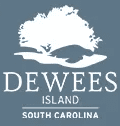About Dewees Island
Today, Dewees Island offers a tranquil escape where residents live harmoniously with nature, preserving its wild landscapes and thriving wildlife. Accessible only by ferry, the island has no paved roads, shops, or restaurants—just miles of pristine beaches, marshlands, and maritime forests. Residents will immerse themselves in a serene environment, exploring by golf cart or on foot, as Dewees remains committed to protecting its fragile ecosystem.
This commitment to conservation has been central to Dewees since the 1970s when developers and environmentalists collaborated to create a community that prioritizes sustainability. With strict guidelines on building and development, every aspect of the island is designed to minimize environmental impact. Homes are built to blend seamlessly with the natural surroundings, and residents participate in ongoing efforts to protect and restore native wildlife habitats.
The island’s rich history stretches back to the days of the Sewee tribe, indigenous people who thrived on these lands for thousands of years. Dewees, then known as "Timicau," served as a hunting and fishing ground, evidenced by ancient shell rings and pottery fragments. When Europeans arrived in the 15th and 16th centuries, the island witnessed significant change, eventually passing into private hands over the following centuries. Through periods of farming, hunting, and quiet solitude, Dewees remained relatively untouched, preserving its unique natural beauty.
Today, Dewees Island stands as a model of intentional, low-impact living. Both residents and visitors can experience the beauty of South Carolina’s coastal wilderness while honoring the island’s storied past.
Click here if you are interested in learning more about the history of Dewees Island.
